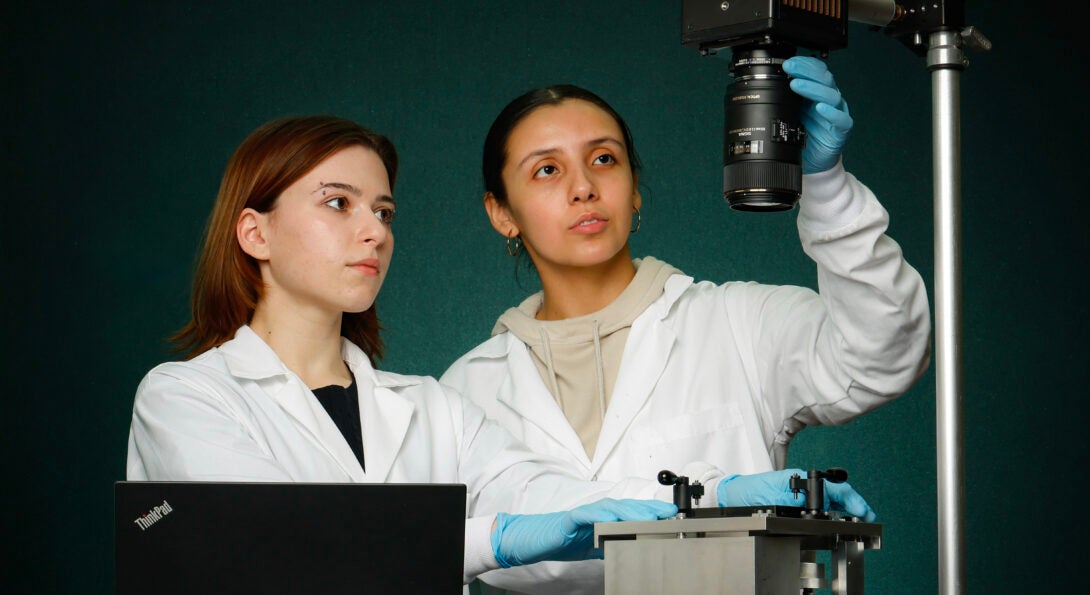Undergraduates first authors on neurotrauma paper

block
From something as simple as bumping your head getting into your car or experiencing a concussion during a football game to more severe injuries such as a hemorrhage, traumatic brain injuries (TBI), skull fractures, spinal column fractures, and spinal cord injuries, there are many causes of neurotrauma. Sudden impacts to the head and spine are a significant cause of morbidity and mortality rates worldwide.
In fact, in the United States, around 1.7 million people suffer a TBI annually, with adolescents between ages 15 and 19 and adults aged 65 and older among the most likely to sustain one, according to the National Institutes of Health.
Richard and Loan Hill Department of Biomedical Engineering seniors and first authors Angela Mitevska and Citlally Santacruz have published a paper in Neurotrauma Reports to identify an alternative cell-culture substrate that enables the long-term culture of human induced pluripotent stem cell (hiPSC)-derived neurons in an in-vitro neurotrauma model.
Mitevska and Santacruz wanted to see that appropriately prepared polyurethane elastomer improves biocompatibility while retaining the mechanical properties necessary for this demanding application. Human in vitro models have also been applied to neurotrauma using stretchable cell-culture substrates. These models reproduce many important acute injury phenotypes. However, they are limited to acute phenotypes because hiPSC-derived neurons cannot survive for long periods on status quo stretchable cell-culture substrates.
HiPSCs can be generated from patients of any genetic background and differentiated into many types of terminal cells. They retain the genome of the donor patient and allow it to be edited precisely to test hypotheses about individual genetic variants. Human in vitro models reproduce important pathological mechanisms in neurological diseases such as bipolar disorder, amyotrophic lateral sclerosis (ALS), and Parkinson’s disease.
Stretch injury models, when neural cells are grown on stretchable substrates, are the most popular type of in vitro neurotrauma models. In status quo stretch injury models, the stretchable cell-culture substrate is composed of polydimethylsiloxane (PDMS). PDMS has a long history of successful application in cell biomechanics. However, PDMS is also mildly neurotoxic, so it is difficult to sustain long-term monocultures and it also disrupts endocrine function, absorbing drugs, which then alters the drug concentration in the cell-culture media.
PDMS and polyurethane both have limitations as mentioned, but they both also have advantages depending on the use.
Mitevska and Santacruz worked to reproduce the clinical conditions of neurotrauma in a cellular format by mechanically applying the trauma physically stretching cells on a flexible membrane, i.e., the PDMS or polyurethane. They found that a highly compatible form of polyurethane can replace PDMS. In doing so, the use of polyurethane makes it possible to maintain hiPSC-derived neurons for long periods in a human in vitro neurotrauma model.
Mitevska and Santacruz have worked in Mechanical and Industrial Engineering Assistant Professor John Finan’s lab since October 2020 and February 2021, respectively.
Finan noted that it is uncommon for undergraduates to publish papers as first authors, but doing so is a testament to their hard work and is indicative of their development as researchers.
Through the Education and Research Training Collaborative (ERTC), Mitevska and Santacruz have worked in Finan’s lab while being paid to work as research assistants at no cost to the faculty that hosted them.
Being part of ERTC and joining Finan’s lab, “was a really foundational start to my college experience because before I had in-person classes, I was doing research with Dr. Finan,” Mitevska said. “Since we started working with ERTC and Stephen Gramsch, the program’s director, we’ve had various opportunities to present our research, both formally and informally. We’ve presented at symposiums and at a meeting with Department of Defense researchers. Dr. Gramsch is very supportive of our professional development and ERTC gives us so many resources to train in different research methods.”
“Having a background in biomedical engineering, we’re able to be knowledgeable in different areas and apply that knowledge to our work in this lab which has allowed us to do some cell-culturing, prototyping, and testing and overall giving us a broad skill set,” Santacruz said.
Participating in this research and the ERTC, “gave them a chance to prove their character, attentiveness to detail, and persistence and we expanded these skills in a systematic way,” Finan said. “We had the space and time to do that because they’ve been working in the lab for three years, so they’ve been able to develop independence and the ability to be in the conversation all the time. More specifically, talking to other experienced scientists, to be presenting their own data, taking questions about it, looking at other people’s data and asking questions about it, and having those conversations day after day.”
Finan said that it’s important to have students develop scientific maturity and the ERTC is a good way to gain that maturity. He added when students gain research experience, they go through the whole cycle of working in a lab, gathering data, and writing paper.
“Now they have a real informed opinion about an academic research career. So, if students want to pursue a career in academia, they do it with a real sense of what they’re getting themselves into which might lead them to something they might otherwise not have considered,” Finan said.